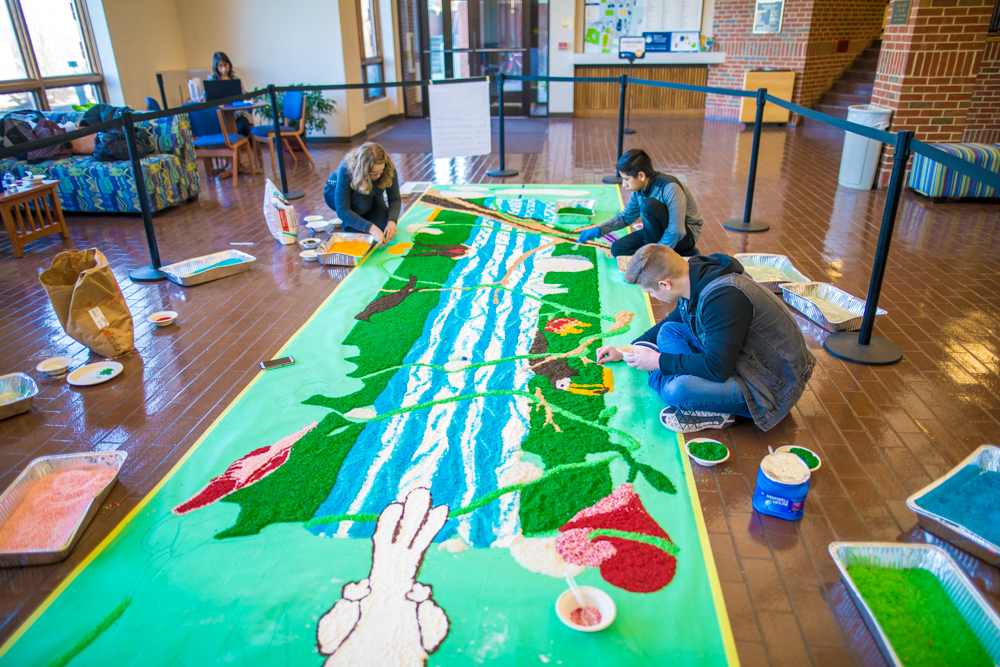Every year on Palm Sunday, communities in Central America recreate the Biblical passage in which Jesus is welcomed into Jerusalem a week before his crucifixion, with his followers laying down palm leaves in front of him as he rode in on a donkey.
Except instead of palm leaves, they make a colorful alfombra, the Spanish word for carpet, or alfombra de Aserrín (“sawdust carpet”), during Holy Week.
See the 2016 and 2015 alfombras.
“Before Easter Sunday, people go out into the streets and make these carpets made out of sawdust and other materials, and they lay them out on the street. They’re not fastened or glued down; they’re just kind of laid on top to make whatever design they want on them,” said Mario Hernandez, 21, a junior and member of Eastern Mennonite University’s Latino Student Alliance. “It’s usually just nature scenes, or like the crucifixion or the resurrection. Other times, it’s just designs with geometric shapes.”

A procession then makes its way through the town to the church, Hernandez explained, with the crowds walking over the carpet.
“In my opinion, it serves two purposes,” he said. “One is: It makes it nicer for the people in the procession; it makes an ambiance. There’s also the idea of taking on some of the burden on the way to the cross.”
EMU’s LSA has created their own alfombra “rug” made primarily out of rice, along with flour, coffee grounds and sawdust, depicting Biblical symbols like a large white dove, a cross, a lamb, a waterfall, a heart and hands and a green vine that weaves throughout the length of the alfombra.
LSA members have been working on the alfombra all semester. “When we started, we had a conversation the second week when we started class … about our faith journey, and then we had to visualize what Jesus means to me during Holy Week,” said Maria Esther Showalter, LSA’s faculty advisor.
Each student made a drawing, and Joshua Curtis, 21, a junior art major, combined all the drawings together to make one big alfombra. They then decided on what themes they wanted to convey.
“A lot of people in the club wanted the natural theme,” he said.

The students color-coded the drawings and then started the dyeing process of the rice using food coloring. They dyed 180 pounds of rice for the alfombra. Coffee grounds and sawdust were donated to the project.
This is the third year LSA has made an alfombra for Easter. Senior Anna Messer learned about the alfombra tradition when she did a cross-cultural trip in Guatemala and Cuba. The 22-year-old said the alfombra has served as a tool to educate the EMU community on Latino traditions while celebrating faith.
“What I really appreciate is how we have organized this, that it’s a collective. It’s inspiring all of us to tap into our artistic imaginations and how we see Easter and how we reflect in it,” Messer said. “Each part of the alfombra is very important because it represents each one of us and our understandings of Easter, so there’s very symbolic meaning behind every piece, from the white dove to the waterfall and the lamb, the cross, all of these things.”
[Editor’s note: The alfombra was the centerpiece of a March 28 chapel service.] Speakers will present the alfombra during the service and discuss the different aspects of the piece and reflect on its meaning. Unlike the usual tradition, the carpet will not be walked on. The students have identified four main themes in the piece that represent Easter: a season of abiding, a season of renewal, a season of hospitality and a season of redemption.
The green vine that courses through the alfombra is meant to symbolize that, if one abides in Jesus, “he’s going to bear much fruit to us,” Messer said. The heart represents “a season of renewal” and “how our hearts are breaking just as Christ’s heart had broke for us and the sin of the world and how he continues to restore and renew in us,” she said.
The clasped hands depict “a season of hospitality,” according to sophomore Anastasia Dronov, 20, who drew the piece. “I thought about how in the family of Christ, everybody is co-suffering through life, but also it’s so hopeful and joyful because you don’t have to do it alone,” Dronov said. “Bad times come, good times come, but no matter what, everybody’s helping each other out. Just how Christ was hospitable to us, he laid down his life for us. In the same way, we reach out to others and help pull them up and they’ll help pull us up.”
The lamb and cross represent “a season of redemption,” in Jesus’ crucifixion and resurrection, as does Zury Lemus’ drawing.”There are two hands with the heart inside and the hands with different colors of brown and white, representing the ethnicity of all of us and the heart — the love we have for each other — and the love of God also. And the drops of blood represents the crucifixion of Christ, that he gave his blood for us,” said Lemus, an exchange student.
The rice will be donated to a local day care center once the alfombra is taken down after the chapel service on March 28.
This article was published in the March 24, 2018, Daily News-Record.
